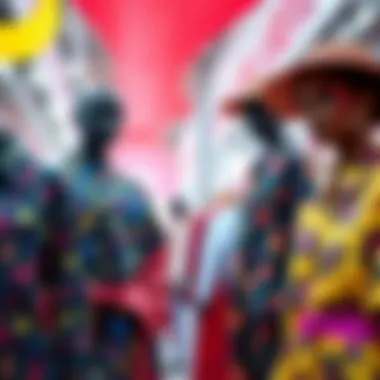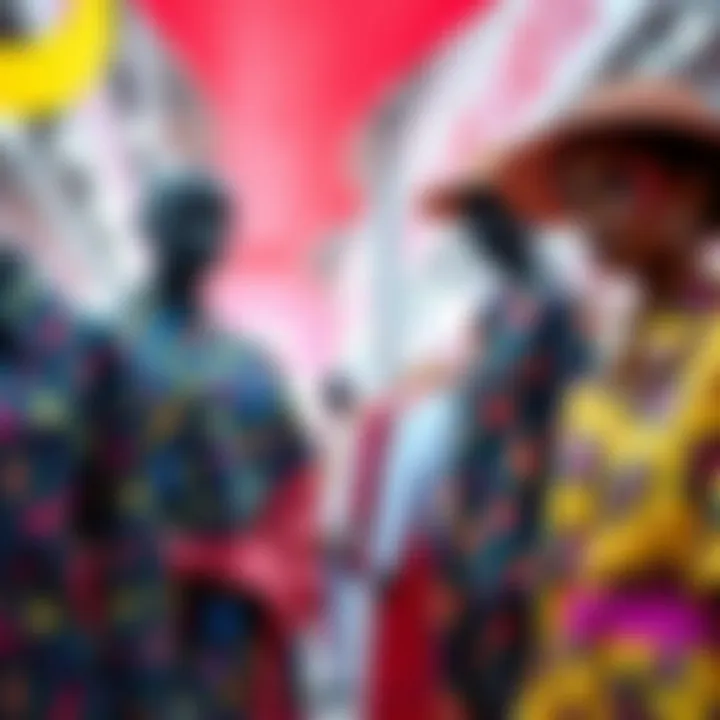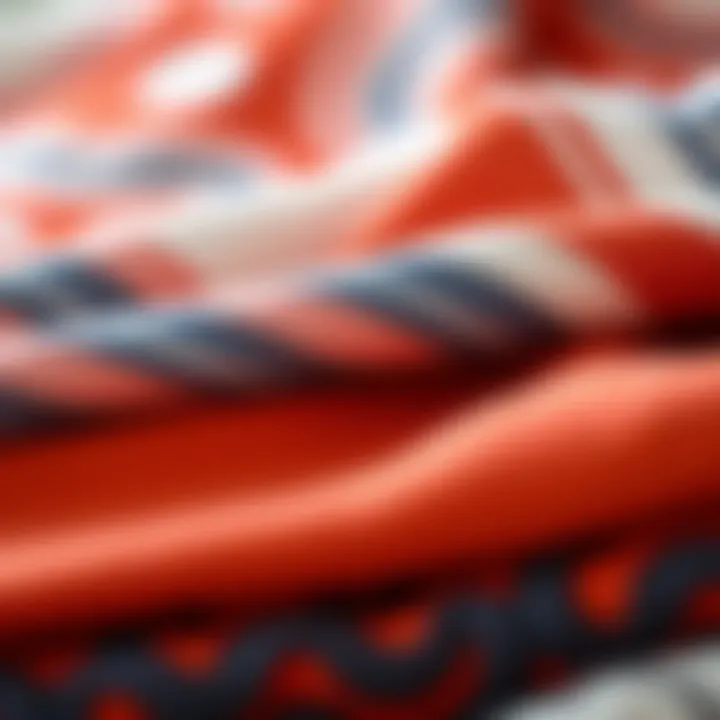Exploring the Trends and Sustainability of Rosewave Clothing


Intro
Rosewave clothing has made waves in the fashion industry, captivating both casual shoppers and ardent enthusiasts. It isn’t just a fleeting trend; it represents a vibrant blend of artistry and consciousness that speaks to our times. Its rise can be attributed to several factors, including an increased demand for unique designs and sustainable practices. This exploration will shed light on the distinctive featuresof Rosewave clothing, the trends that define it, and the ecological impact of its production—creating a wholesome understanding that appeals to fashion lovers and boutique owners alike.
Fashion Trends
Emerging Styles
In the realm of Rosewave clothing, creativity knows no bounds. Designers are embracing a sense of nostalgia, drawing from various fashions of the past while marrying them with modern sensibilities. From flowing silhouettes adorned with floral patterns to striking color palettes that disrupt conventional expectations, the styles emerging under the Rosewave label reflect an amalgamation of the eclectic and the timeless.
Several key characteristics define these looks:
- Layering: Whether it’s pairing a lightweight, airy dress with a chunky sweater or mixing textures and patterns, layering is critical in creating depth and personal expression.
- Statement Accessories: Oversized hats, vibrant handbags, and jewelry that spark conversation are staples in the Rosewave wardrobe, often completing a look that feels both bold and deliberate.
Given that style and individuality run hand in hand, the emergence of upcycled elements—where old garments are reimagined into something new—has been noteworthy. Innovators are pulling from thrift stores and vintage boutiques, creating a fresh yet familiar aesthetic.
Seasonal Must-Haves
As with any trend, each season brings with it a new wave of must-have pieces that reflect the heart and soul of Rosewave. Here’s a glimpse at some essentials:
- Spring/Summer: Expect airy fabrics, with dresses that flow, maxi lengths, and pastel hues, resembling petals in bloom. Functional yet stylish sandals and wide-brimmed hats also gain prominence.
- Fall/Winter: Think layering with luxurious cardigans, chunks of woven textures, and earth-tone palettes. Scarves that wrap snugly and outerwear boasting distinct patterns encapsulate the cozy spirit of colder months.
Such seasonal necessities not only keep wardrobes fresh but also invite a thoughtful approach towards purchasing habits.
Fabric and Sustainability
Eco-Friendly Materials
A hallmark of the Rosewave movement is its commitment to sustainability. Incorporating eco-friendly materials, brands prioritize fabrics like organic cotton, Tencel, and recycled polyesters, which reduce overall environmental impact and promote healthier production practices. By supporting local artisans and focusing on minimal waste, companies making Rosewave clothing exemplify the shift toward responsible fashion.
Impact of Textile Production
The environmental implications of textile production cannot be overlooked. Fast fashion has left a lasting stain on our planet, leading many consumers to seek out alternatives. With Rosewave clothing, we see a concerted effort to educate consumers about the accompanying repercussions:
"Every piece of fabric has a story, from its origin to its journey in our closets. Understanding that tale is crucial for making responsible choices."
With careful consideration of water usage, chemical run-off, and labor conditions, the artisans and designers behind Rosewave are carving out a space where style meets ethical responsibility.
In a world often dominated by mass production, Rosewave clothing stands as a beacon of mindful consumerism, inviting not just a change in the wardrobe but a shift in perspective toward how we view fashion as a whole.
Preamble to Rosewave Clothing
Rosewave clothing represents a groundbreaking fusion between style and sustainability, making a significant impact on contemporary fashion. Its importance lies not only in the visual appeal it offers but also in its commitment to the environment and ethical practices, which are increasingly crucial in today’s marketplace. As fashion enthusiasts and boutique owners explore new trends, understanding the allure of Rosewave becomes indispensable.
Definition and Characteristics
Rosewave clothing can be defined as a collection of apparel that emphasizes floral motifs, soft color palettes, and fluid silhouettes that resonate with both nature and femininity. The style draws inspiration from soft, dreamy aesthetics that evoke feelings of tranquility. Key characteristics include:
- Natural Fabrics: Often crafted from organic cotton, linen, or recycled materials, ensuring comfort and eco-friendliness.
- Floral Patterns: Seasonally inspired prints, from dainty blossoms to bold bouquets, elevate the aesthetic.
- Flowing Lines: The designs often feature relaxed, effortless cuts that cater to both casual and formal settings.
- Color Harmony: Pastel flavors or warm earth tones blend to create a gentle yet striking appearance.
With these traits, Rosewave clothing stands out from traditional fashion trends, celebrating individuality and eco-conscious living.
Historical Context
The rise of Rosewave clothing can be traced back to the resurgence of eco-fashion in the early 21st century when consumers began to demand more sustainable options from the fashion industry. As society became more aware of environmental issues, brands responded by developing clothing that not only embraces aesthetics but also promotes responsible consumption.
Furthermore, movements such as slow fashion played a critical role in shaping the ethos of Rosewave. This approach encourages a slower pace in fashion cycles, focusing on quality over quantity. Local artisans, designers, and brands began to appreciate the art of sustainable craftsmanship. As a result, Rosewave emerged as a celebrated style within this context — a perfect blend of beauty and conscientious living.
The Visual Aesthetic of Rosewave
The visual aesthetic of Rosewave clothing holds a paramount significance as it encapsulates an artistic vision that lines up with modern values. This style is not merely a fashion choice; it’s an expression of individuality and a nod to sustainability. By blending colors, patterns, and distinct design elements, the Rosewave aesthetic offers a fresh yet timeless approach to everyday wear, appealing to a broad spectrum of consumers—from those who check the latest trends to those who seek meaningful pieces. The balance between aesthetic appeal and ethical considerations is crucial in today's fashion landscape.
Color Palettes and Patterns
When discussing color palettes in Rosewave clothing, one can’t ignore the soft pastels and vibrant hues that often dominate the scene. Shades of blush pink, mint green, and lavender create an ethereal vibe, reminiscent of a sunrise or spring bloom. These gentle colors embody a sense of calm and serenity, making them well-suited for a variety of occasions, whether it’s a casual brunch or an evening gathering.
Patterns also play a vital role in establishing the Rosewave identity. Floral prints are a common sight, evoking feelings of nature and renewal. However, geometric figures and abstract designs are finding their way into this style, creating a playful yet sophisticated contrast. The rhythmic interplay of colors and patterns not only elevates the garment's visual appeal but also encourages personal expression within the wearer. A well-chosen pattern can turn a simple outfit into a canvas, speaking volumes about the individual’s tastes and preferences.
Design Elements
Texture
Texture is an integral part of the Rosewave aesthetic that elevates its overall charm. Fabrics like soft cotton, lightweight linen, and flowing chiffon are favored, presenting a tactile experience that is both inviting and comfortable. The soft touch of these materials echoes the gentle spirit of the Rosewave style. High-quality textures often denote a commitment to sustainability, aligning with the principles of ethical fashion.
A unique feature of texture in Rosewave clothing is its ability to create depth. For example, an outfit might combine a smooth, flowing dress with a chunky knit cardigan, giving visual interest while maintaining a cohesive look. This variety encourages mixing and layering, allowing for versatility and adaptability appropriate for changing weather and personal preferences.
Silhouette


Every fashion aficionado knows that the right silhouette can make or break an outfit. In Rosewave clothing, the silhouettes tend to emphasize soft lines and feminine shapes. From relaxed fits to structured styles that flatter various body types, the silhouettes are designed to be both stylish and comfortable.
The key characteristic of these silhouettes is their ability to drape gracefully over the body. This fluidity allows freedom of movement, making Rosewave apparel particularly appealing for everyday wear. A standout feature might be an A-line dress—a classic choice that flatters many figures while keeping the silhouette effortlessly chic.
Layering Techniques
Layering in Rosewave fashion is an art form that adds dimension to any outfit. This technique allows individuals to express their creativity by blending different pieces to craft a unique look. A light scarf tossed over a sundress or a denim jacket layered atop a flowy top exemplifies the charm of Rosewave layering.
What makes layering particularly advantageous is its practical appeal. It equips wearers to transition seamlessly between indoor and outdoor settings, especially during fluctuating temperatures. Each addition not only serves a functional purpose but also enriches the overall aesthetic, creating depth and contrast in materials and colors.
The visual aesthetic of Rosewave is more than just a combination of colors and fabrics; it's a deliberate choice reflecting personal values and styles.
Styling Rosewave Apparel
Styling Rosewave apparel is not just an exercise in putting outfits together; it’s an exploration of identity and artistry in the fashion realm. The Rosewave aesthetic, with its unique color palettes and innovative designs, invites individuals to express their personality and enhance their presence in various social contexts. It's essential because the way one styles clothing can dramatically influence how they are perceived in different settings, from casual meet-ups to formal gatherings.
Occasions for Wearing Rosewave
The Rosewave style proves to be versatile, making it suitable for various occasions. Whether it's a brunch outing, a music festival, or a more polished cocktail event, there’s a way to incorporate Rosewave into the mix. The approach to styling depends significantly on the event type.
- Casual Gatherings: Think soft fabrics and vibrant shades that feel easy-going yet chic. A well-fitted Rosewave dress paired with neutral-toned sandals could work wonders.
- Office Wear: Incorporating Rosewave into work attire doesn't have to be daunting. A structured Rosewave blazer over tailored trousers can strike a balance between professionalism and personal creativity.
- Evening Functions: For a night out, consider layering Rosewave pieces. A flowing Rosewave skirt complemented by statement jewelry and a simple top adds an elegant touch.
Mixing and Matching
Mixing and matching Rosewave apparel isn't just about looking good; it’s about creating ensembles that tell a story. How one blends different styles can greatly affect their overall vibe. Here’s where creativity comes into play.
Complementary Accessories
Complementary accessories can be the icing on the cake for a Rosewave outfit. Accessories can elevate a simple look to something truly striking, showcasing personal flair. Think of bold handbags, colorful scarves, or unique jewelry that resonates with the Rosewave style. This blend offers a fun way to express individuality. Moreover, accessories can reinforce the color scheme, creating a cohesive appearance.
- Key Characteristics: They add flair without overwhelming the outfit. Light layering with delicate pieces could harmonize well with bolder prints without stepping on the toes of the main outfit.
- Advantages: Accessories provide flexibility; they allow for easy changes to the overall look without needing to overhaul the entire outfit. You can transition from day to night effortlessly.
- Unique Features: The real charm lies in their ability to transform an outfit. A simple shift dress becomes eye-catching with the right statement earrings or an unexpected belt.
Footwear Choices
Footwear choices play a critical role in achieving the right balance in styling. They can make or break an outfit. When it comes to Rosewave, the key is to pick shoes that complement the clothing without stealing the limelight. Sneakers can provide a casual touch for daytime, while heels may elevate the elegance for evening events.
- Key Characteristics: Comfortable yet stylish footwear ensures that an overall look remains approachable. Chunky boots with a flouncy skirt can create an interesting contrast.
- Advantages: Proper footwear enhances the overall fit, supporting the body in various settings—from standing at a music festival to dancing at a wedding.
- Unique Features: Choosing footwear with unique designs can echo the Rosewave trend, enhancing the style without compromising comfort. Think of handmade sandals from local artisans that provide that personal touch.
"Fashion is about dreaming and making other people dream." – Donatella Versace
The Influence of Social Media
The impact of social media on fashion is akin to a double-edged sword; it wields great power and influence while simultaneously presenting challenges. In the realm of Rosewave clothing, platforms like Instagram, TikTok, and Pinterest have become crucial in shaping visibility, trends, and consumer interaction. The real strength of social media lies in its ability to create communities rooted in specific aesthetics, allowing Rosewave to bloom across diverse circles of fashion enthusiasts, designers, and everyday consumers.
Emergence of Rosewave Influencers
Social media influencers have become the modern fashion arbiters, cultivating niche followings and launching micro-trends with a click of a button. The Rosewave aesthetic has seen a surge in influencers who embody the style's principles, showcasing outfits that are both vibrant and thoughtful. These individuals often curate their profiles around a distinct visual language, engaging their audience with not just clothing, but lifestyle choices that promote positivity and self-expression.
Influencers often collaborate with brands to promote collections that resonate with their audience. These partnerships can often lead to limited-edition releases or exclusive content that draws in both new customers and loyal followers. Notably, influencers help bridge the gap between high fashion and daily wear, making Rosewave accessible to the masses.
Impact on Trends and Styles
Social media is a rapid incubator of trends; it pushes the boundaries of creativity while establishing what’s ‘in’. For Rosewave, the visuals presented by influencers and regular users alike contribute to a rich tapestry of style that often blurs the line between seasonal trends. Here are some noteworthy impacts:
- Virality of Designs: Once a model or influencer showcases a particular Rosewave outfit, it often goes viral, with countless imitations flooding fashion feeds.
- Democratized Style: Individuals from various backgrounds can now partake in trendsetting without needing access to elite fashion circles. This leads to diverse representations in the Rosewave community.
- Consumer Feedback Loop: Social media allows consumers to shape trends in real time. Feedback from followers can directly impact design choices, leading brands to adapt quickly to the desires of their audience.
The swirling influence of social media has made it possible for Rosewave clothing not just to thrive but to redefine what modern fashion is. It’s not merely about the pieces but also the stories we tell around them.
The way styles emerge, evolve, and often fade on platforms speaks volumes about the collective consciousness of fashion lovers. In the case of Rosewave, social media acts as a vibrant canvas, allowing the aesthetic to transform continually while making it more entrenched in everyday culture.
Market Trends in Rosewave Clothing
The landscape of fashion is ever-evolving, and the emergence of Rosewave clothing signifies an exciting new chapter. Understanding market trends in Rosewave clothing is vital, as it helps illuminate consumer behaviors, preferences, and the driving forces behind this niche fashion movement. As style enthusiasts are always in search of the next big thing, Rosewave caters to this curiosity while addressing sustainability—a concern of significant importance in today’s fashion world.
Consumer Preferences
Consumer preferences play a pivotal role in shaping the market dynamics of Rosewave clothing. Shoppers nowadays are more informed and conscientious, gravitating towards brands that align with their values. They seek designs that not only resonate aesthetically, but also reflect a commitment to ethical practices.
Here are some key points concerning consumer preferences in the Rosewave sector:
- Sustainability Focus: A significant percentage of buyers today prioritize eco-friendly materials and sustainable production methods. Brands that utilize organic cotton, recycled polyester, and other earth-conscious textiles see a noticeable rise in interest.
- Diversity in Sizing: Celebrating body positivity, many consumers now favour brands that offer an extensive range of sizes, catering to all body types. Rosewave brands that embrace inclusivity tend to gain more traction and loyalty.
- Personalization and Identity: Today’s consumers are keen on expressing their unique identities through fashion. This trend has led to a demand for limited editions or customizable pieces that reflect one’s personal style, setting Rosewave apart from mainstream clothing.
As we dive deeper into the consumer psyche, it becomes clear that those who embrace Rosewave clothing are seeking more than just an outfit; they are embracing a lifestyle that reflects their values.
Brands Leading the Charge
The surge in popularity of Rosewave clothing has sparked a wave of innovative brands setting the gold standard in this trend. These companies not only offer eye-catching designs but also uphold accountability in their operations. Brands that have distinguished themselves in the Rosewave sphere include:
- Reformation: Known for its chic, vintage-inspired pieces, Reformation is committed to sustainability. Their transparency regarding sourcing and production resonated deeply with Rosewave aficionados.
- Amour Vert: This brand emphasizes eco-friendly practices combined with modern aesthetics. Their mission to plant a tree for every t-shirt sold has struck a chord with consumers looking to make a positive impact.
- Mara Hoffman: With a focus on bold colors and patterns, this label reflects Rosewave's visual aesthetics while adhering to sustainable couture principles. Their designs tell a story, satisfying those who crave both style and substance.
These brands exemplify how the Rosewave movement's essence is not solely in its designs; it's about fostering a community that champions ethical fashion. By leading with responsibility and creativity, they carve a path that others in the industry may aspire to follow.


"Fashion is not about what you wear, but how you wear it while making a difference."
As we anticipate the future of Rosewave clothing, these trends signal a promising integration of personal choice with global responsibility.
Sustainability in Rosewave Fashion
The conversation around sustainability in fashion has taken a front-row seat, and Rosewave clothing is no exception. The demand for sustainable practices in the fashion industry has surged, driven by consumers who are increasingly aware of their environmental footprint. In this light, Rosewave emerges with a promising narrative that incorporates both style and sustainability to resonate with today’s conscientious shoppers.
While the aesthetics of Rosewave draw attention, it’s the sustainable backbone that strengthens its appeal. The core of sustainable fashion lies in its commitment to reducing environmental harm, promoting ethical production, and fostering equitable labor practices. By adopting sustainable methods, Rosewave brands aim not only to provide beautiful, unique garments but also to ensure that their business practices lead to a healthier planet.
Ethical Fabric Choices
In the realm of Rosewave, the narrative of sustainability begins with fabric choice. Brands are increasingly gravitating toward organic and recycled materials. Organic cotton, for example, stands out for its minimal use of pesticides and better water management compared to conventional cotton farming. This choice isn’t just about being trendy; it signifies a paradigm shift towards responsible sourcing that has a lower carbon footprint.
The manufacturing process of fabrics from synthetic fibers, often derived from petroleum, raises environmental concerns. Therefore, choosing materials like Tencel or hemp is gaining traction. Both fibers demand less water and fewer chemicals, proving beneficial for the natural ecosystems they draw upon.
Here are some ethical fabrics notably favored in Rosewave clothing:
- Organic Cotton: Grown without harmful chemicals, it’s kinder to the earth.
- Tencel: Made from eucalyptus trees, it offers both softness and sustainability.
- Recycled Polyester: A recycled option derived from plastic bottles that reduces waste.
Production Practices
Delving deeper, we find that sustainability in Rosewave is not solely reliant on fabric choices but extends to production practices as well. Brands are increasingly opting for eco-friendly techniques and local sourcing to minimize their overall environmental impact.
Eco-friendly Techniques
One option that is gaining ground in production techniques is the use of waterless dyeing technology. Traditional dyeing methods can be water-heavy and polluting. However, waterless dyeing technology employs innovative methods such as airbrushing, drastically reducing water use, and mitigating harmful chemical runoff.
"Waterless dyeing represents a significant leap toward sustainable practices by lessening ecological damage while maintaining vibrancy in colors."
Not only does this method lessen the strain on water resources, but it also ensures that energy consumption is kept to a minimum, aligning perfectly with the ethos of Rosewave. Some brands further extend their eco-friendly approach by using low-impact dyes that avoid toxic chemicals, contributing positively to both the environment and wearers’ skin.
Local Sourcing
When it comes to local sourcing, the benefits stretch beyond just sustainability; they bring communities closer. By sourcing materials and manufacturing locally, brands like those in the Rosewave category can significantly cut down on transportation emissions, ensuring a smaller overall carbon footprint. This approach inherently supports regional economies, creating jobs and fostering a sense of community.
Crucially, local sourcing enables brands to maintain higher standards of quality and ethical practices, often offering more transparency to consumers.
A unique feature of local sourcing is the ability to respond swiftly to customer preferences. With shorter supply chains, collections can be updated and adjusted in real-time reflecting current trends. This agility is extremely valuable in a fast-paced fashion environment.
However, the reliance on local materials can come with challenges, such as limited availability of specific fabrics, which might restrict design possibilities. Despite that, the advantages of minimizing environmental impact and promoting local craftsmanship often outweigh these drawbacks.
Cultural Impact of Rosewave Clothing
The cultural impact of Rosewave clothing extends beyond mere trends and styling; it embodies a movement that resonates deeply with the shifting values of society today. As fashion continuously evolves, Rosewave serves as a bridge between personal expression and social awareness. This section dives into the nuances of how this clothing style influences culture and vice versa, offering insights that cater especially to fashion enthusiasts and boutique owners alike.
Global Influence and Localization
In our increasingly interconnected world, Rosewave clothing exemplifies the global exchange of ideas and aesthetics. Designers and brands now find themselves influenced by a vast array of cultural motifs, merging them to create something both recognizable yet unique. For instance, while the soft pastel colors often associated with Rosewave can be traced back to Western pop culture, elements from Eastern traditions are subtly woven into the designs. This fusion highlights the adaptability of Rosewave styles across cultural boundaries.
An important aspect of this global influence is localization. Different regions interpret Rosewave in distinct ways, infusing local textiles and heritage patterns into the garments. This practice not only preserves traditional crafts but also resonates with consumers who value authenticity in fashion choices. The local twists on Rosewave not only provide depth to the overall aesthetic but also foster economic empowerment within communities, allowing artisans to thrive.
Moreover, it reflects a growing desire among consumers to connect with pieces that tell a story—artisans pouring their cultural narratives into the very fabric of clothing.
Art and Expression
Fashion Shows
Fashion shows dedicated to Rosewave clothing offer a vibrant platform for designers to showcase their creativity while promoting the cultural dialogue inherent in this style. These events are more than just a display of fabric and thread; they are a celebration of heritage and innovation. A key characteristic of Rosewave fashion shows is their interactive nature, often involving multimedia elements that engage the audience on multiple levels.
This visibility is beneficial as it bridges the gap between the niche fashion world and the mainstream. Attendees not only see the garments up close, but also experience the motivation that drives the designers behind Rosewave. They highlight storytelling, allowing designers to express a deeper message, often focusing on themes of sustainability and cultural appreciation.
Fashion shows also harness social media, enabling designers to reach beyond the physical venue, thus enhancing the cultural dialogue surrounding Rosewave. However, the common critique lies in the potential for exclusivity in access, which can limit the broader discourse that might otherwise be fostered through diverse viewpoints.
Street Art
Street art serves as a powerful medium for expressing the ethos of Rosewave culture. In urban spaces, murals and installations often reflect the aesthetics and values associated with this clothing trend. Visually striking, street art embodies the essence of Rosewave by incorporating vibrant colors and organic forms found in nature, paralleling the clothing's design principles.
The street art scene elevates Rosewave fashion by providing a context that is accessible to the public. This open expression is critical because it democratizes art and fashion, allowing communities to engage with themes that resonate on personal and local levels. Moreover, the artworks often encourage dialogue around sustainability and social issues, which are integral to the Rosewave movement.
The downside? Street art can sometimes be ephemeral—existing only momentarily before new works erase the old. Still, its transient nature invites constant renewal and excitement, keeping the cultural conversation alive in vibrant and diverse ways.
Ultimately, the cultural impact of Rosewave clothing cannot be understated. It is a dynamic interaction of tradition, innovation, and collective dialogue that shapes both the fashion landscape and the community’s identity.
In summary, the cultural elements of Rosewave clothing showcase a rich tapestry of influence and interpretation. From global inspirations adapted locally to the expressions found in street art and fashion shows, this genre of clothing is a powerful medium for dialogue—a phenomenon that is here to stay.
Challenges Facing Rosewave Clothing


The landscape of fashion is ever evolving, and the challenges facing Rosewave clothing exemplify some of the most pressing issues in contemporary apparel design and consumption. As Rosewave clothing seeks to make a splash in the fashion world—balancing aesthetics with sustainability—it’s crucial to understand the significant hurdles it must overcome. These challenges not only shape how brands approach design but also influence consumer behavior and market dynamics.
Market Saturation
In an era where trends come and go quicker than one can catch their breath, market saturation poses a serious threat to brands pursuing the Rosewave niche. With more designers tapping into this aesthetic, the distinctive qualities that set Rosewave apart are getting muddied.
A common pitfall here is that numerous brands may replicate each other's concepts, leading to confusion among consumers. They might struggle to identify authentic Rosewave offerings amidst a sea of similar styles. This overabundance in the marketplace might create a scenario where true aesthetics are overshadowed by trends lacking originality. Moreover, as boutiques and online retailers curate their collections, they often feature a dizzying array of choices. This can frustrate shoppers, making them less likely to explore deeper into specific brands or styles, ultimately creating a disconnect between consumer enthusiasm and sales.
Points to Consider
- Unique Value Proposition: As the market becomes saturated, each brand needs to carve its unique identity. That means delivering something that can’t be easily replicated.
- Quality vs. Quantity: Firms must focus on producing quality garments and not just on spewing out items to keep up with demand.
- Consumer Education: Brands must invest in educating their consumers about what makes Rosewave truly unique so shoppers can feel confident in their purchases.
Consumer Misconceptions
Another considerable challenge is the cloud of consumer misconceptions surrounding Rosewave clothing. People often have pre-defined notions about fashion trends, which can lead to misunderstanding and misrepresentation of the Rosewave ethos. Some might view it as just another fad rather than recognizing its cultural significance and sustainability efforts.
Often, potential consumers may believe that sustainable fashion is inherently high-priced, leaving them hesitant to invest in Rosewave pieces. Others might figure that “sustainable” means compromising style for ethics. However, many brands in this space work diligently to meld aesthetic appeal with eco-conscious choices, showcasing that sustainability does not mean a lack of style.
Addressing the Misunderstandings
- Marketing Efforts: It’s necessary for Rosewave brands to convey their unique value effectively, emphasizing the blend of style, sustainability, and cultural elements.
- Consumer Testimonials: Real stories from those who wear Rosewave clothing can help bridge the gap. Satisfied customers can redefine perceptions.
- In-store Experiences: Engaging with consumers through workshops or events can help demystify Rosewave clothing and explain its backstory and significance.
Understanding the challenges facing Rosewave clothing not only provides insight into its current realities but also highlights areas of opportunity for genuine commitment towards creativity, sustainability, and cultural representation in fashion.
The issues of market saturation and consumer misconceptions are integral to navigating the Rosewave landscape. As the industry continues to evolve, facing these challenges head-on can pave the way for innovative solutions that ensure the longevity and relevance of Rosewave clothing in the fashion narrative.
Future of Rosewave Clothing
The exploration of the future of Rosewave clothing can’t be understated, as it reflects the changing tides of consumer behavior and trends in the fashion industry. This section aims to dissect anticipated shifts within this niche, look into technological advancements shaping its trajectory, and detail how these elements combine to affect sustainability efforts.
Predicted Trends
When one considers the future of Rosewave clothing, several trends are likely to take center stage.
- Sustainable Practices on the Rise: More brands are expected to adopt eco-friendly materials. Think organic cotton and recycled fabrics becoming staples, as shoppers increasingly demand transparency in sourcing.
- Inclusivity in Sizing and Styles: There's a growing push for clothing that fits a variety of body shapes and sizes. This is more than just a trend; it's about making fashion accessible for everyone.
- Blurring Gender Lines: With societal norms shifting, gender-neutral clothing is becoming more prominent. Rosewave designs may include versatile styles that challenge traditional gender classifications.
- Influence of Vintage Aesthetics: Drawing from the past, many styles may look to retro influences, giving a nostalgic spin while offering modern comfort.
Regardless if trends evolve slowly or change overnight, they paint a compelling picture of how the ethos of Rosewave clothing can resonate more widely.
Role of Technology
The influence of technology on the fashion landscape cannot be glossed over. Here, two key advancements are pivotal in shaping the future of Rosewave clothing.
Virtual Fashion
Virtual fashion is not just a buzzword. Its significance lies in how it allows consumers to engage with clothing without needing physical items. Brands like The Fabricant have led the charge by creating digital-only garments that can be worn in virtual spaces.
"Virtual fashion reduces waste while offering limitless creativity."
Key characteristics include:
- Cost-Effective: Designing digitally often requires fewer resources than traditional methods.
- Innovative Marketing: Virtual clothing can be uploaded onto social media platforms, creating a unique buzz and even helping brands save on inventory costs.
- Customization: Users can create styles that reflect personal tastes without the environmental impact of mass production.
Understanding its trajectory shows that while not all are on board with digital clothes, they provide an avenue for creativity that’s hard to ignore.
AI Design Tools
AI design tools are fundamentally changing how designers approach apparel creation. These tools can analyze trends, consumer preferences, and even create designs autonomously. The likes of Adobe Sensei aid in forecasting colors and patterns that will resonate with buyers.
Key advantages include:
- Timeliness: AI can respond to trends in real-time, enabling brands to pivot swiftly to meet consumer demand.
- Customization at Scale: Creating bespoke designs tailored to specific consumer needs adds a personal touch, often resulting in higher customer satisfaction.
- Sustainability Integration: By optimizing the design process and reducing waste, AI technologies encourage sustainable practices within the industry.
However, challenges persist as some worry about the loss of the human touch in fashion design. Brands must balance tech with authenticity, striving toward a future that values both innovation and artistry.
Closure
The exploration of Rosewave clothing encapsulates not only a unique aesthetic in modern fashion but also highlights the interwoven importance of consumer behavior, sustainability, and cultural expression. As we find ourselves navigating an era where fashion speaks volumes about individual identity and collective societal values, Rosewave emerges as a compelling trend that resonates on multiple levels. To put it simply, it's not just clothing; it reflects a lifestyle philosophy that embraces both beauty and responsibility.
Final Thoughts on Rosewave Clothing
In the realm of fashion, Rosewave clothing stands out for its blend of vibrant colors and textured fabrics. The style draws deeply from nature, with soft earth tones paired with bold floral patterns that can brighten any wardrobe. This aesthetic not only attracts those with an eye for design but also resonates with individuals who value the stories behind their garments.
Moreover, this trend promotes inclusivity and self-expression. Whether layered for a casual coffee date or dressed up for a night out, the versatility of Rosewave allows wearers to adapt styles to their personal taste and occasion. In effect, it encourages a form of storytelling through attire, inviting the wearer to curate their identity through thoughtfully selected garments.
"Fashion is a way to say who you are without having to speak."
This quote encapsulates the essence of Rosewave; it allows individuals to express their inner selves and connect with a broader community that treasures similar values.
Call to Mindful Fashion Consumption
As the conversation around sustainability gains momentum, it's vital for us to reflect on our purchasing choices. Rosewave clothing not only appeals to aesthetic sensibilities but also encourages a mindful approach to fashion consumption. Choosing brands that prioritize ethical production and environmental stewardship can lead to significant impacts.
Here’s how individuals can embrace this mindful philosophy:
- Research Your Brands: Invest time in understanding the brands you choose to support. Look for transparency in their supply chain and commitment to sustainable practices. Websites like Fashion Revolution can provide insight.
- Opt for Quality Over Quantity: Investing in a few high-quality pieces rather than a multitude of cheap alternatives aligns perfectly with the principles of Rosewave. It not only enhances your wardrobe but also helps reduce waste in the fashion industry.
- Support Local Artisans: Many Rosewave collections are crafted by local artisans who emphasize craftsmanship and eco-friendly techniques. Supporting them keeps arts alive and ensures that fair wages are provided.
- Engage in a Circular Fashion Economy: Consider purchasing pre-owned items, swapping outfits with friends, or donating clothes that no longer serve you. This cycle of sharing and reusing supports sustainability.







